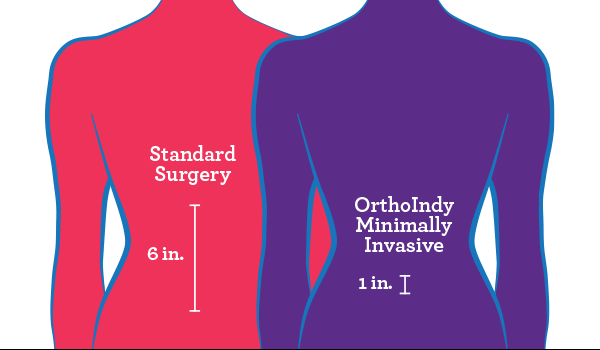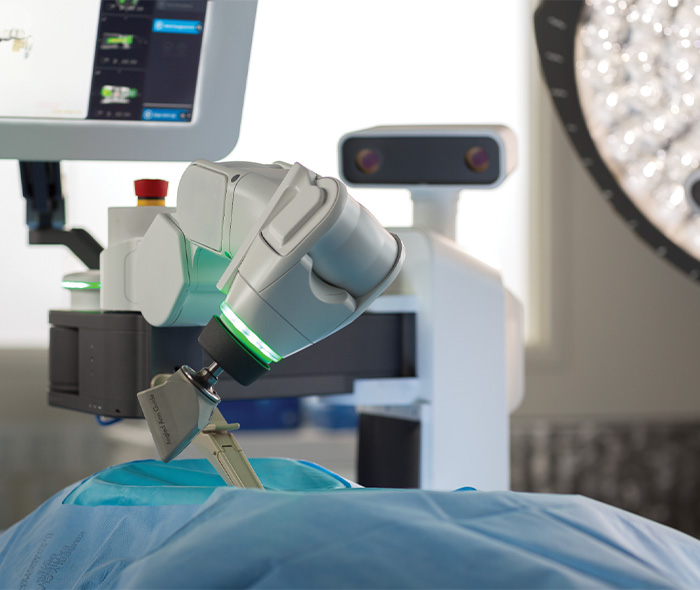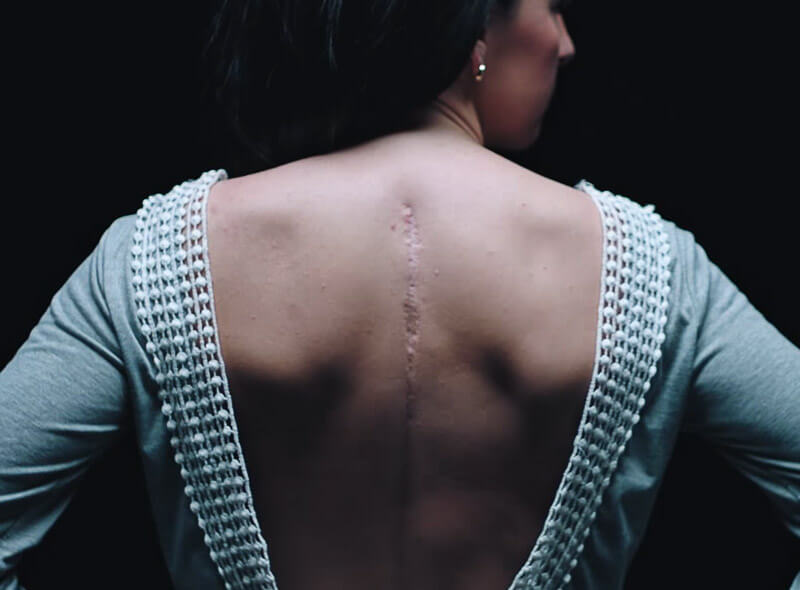A Patient's Comprehensive Guide
Benefits of minimally invasive spine surgery
Considering back or neck surgery? Read this guide to learn how minimally invasive spine surgery can reduce your pain, speed up your recovery, and decrease the risk of complications.

Jump to a section
Back surgery with less pain and faster recovery is possible
No one should have to live with chronic back pain, but the idea of undergoing spinal surgery can be scary. Fortunately, advancements in technology have paved the way for minimally-invasive techniques that make surgery and recovery faster and less painful.
If you’re considering back surgery or are looking for a second opinion, the award-winning team at OrthoIndy can help you explore your options. OrthoIndy is the #1 hospital in Indiana for medical excellence in spinal surgery and also #1 in the market for patient saftey in spinal surgery (2021 – 2024 Carechex® Awards by Quantros).
In this comprehensive guide to minimally invasive spine surgery, you’ll find information about the different types of minimally invasive procedures and their benefits, what to expect with recovery and more.
1 Different types of back surgery
The term “minimally invasive” doesn’t define a specific type of back surgery but rather describes the techniques and methods used. There are several types of procedures performed to treat many different back conditions that fall into the minimally invasive category.
Minimally invasive spine surgery vs. traditional surgery
Minimally invasive spine surgery is performed with the least disruption possible to surrounding tissue. It is just as effective as spinal surgeries performed with traditional methods, and in many cases, much safer.
At OrthoIndy, most spinal surgeries performed are minimally invasive, using advanced techniques in which the surgeon can go in from the back, front or side (lateral).
Their highly-trained team has developed ways to perform minimally invasive procedures on any area of the back, from the neck to the lower spine.
By disrupting less of the body’s tissues and muscles during surgery, most patients experience less pain and a faster recovery. Traditional surgical methods disrupt more tissues and muscles, creating more areas that will ultimately need to heal. This means more pain for a more extended period after surgery.
What types of conditions can be treated with minimally invasive spine surgery?
Spine surgeons can treat many conditions and injuries with minimally invasive spine surgery. A few of the most common include:

- Herniated disc
- Degenerative disc disease
- Pinched nerve
- Back pain from sciatica
- Scoliosis
- Kyphosis
- Neurofibromatosis
- Spinal instability
- Osteomyelitis (discitis)
- Spondylolisthesis
- Spinal trauma
What are the different types of minimally invasive procedures?
Several different types of surgery can be performed using minimally invasive techniques, including:
- Lumbar fusion
- Lateral lumbar interbody fusion
- Extreme lateral interbody fusion (XLIF)
- Lumbar discectomy
- Anterior cervical discectomy
- Anterior longitudinal ligament resection (ALL resection)
- Anterior lumbar interbody fusion (ALIF)
- Direct lateral interbody fusion (DLIF)
- Transforaminal lumbar interbody fusion (TLIF)
- Artificial cervical disc replacement or total disc replacement (TDR)
- Kyphoplasty
- Laminectomy
- Laminotomy
- Percutaneous posterior pedicle screw fixation
- Microendoscopic discectomy
- Corpectomy
- Posterior cervical microforaminotomy (PCMF)
- Thoracotomy
- Video-assisted thoracoscopic surgery (VATS)
Patient story: Greg’s minimally invasive spine surgery for a herniated disc
High school athletic director and baseball coach, Greg Marschand, threw his back out while setting up a fence in preparation for baseball season. As his injury persisted, Greg knew something was seriously wrong—especially when he could no longer bend over to put on his shoes.
At his local hospital, an MRI showed that Greg had a herniated disc putting pressure on a nerve in his right leg. Greg’s primary doctor recommended he seek expert care, and he scheduled an appointment with OrthoIndy spine surgeon, Dr. Kevin O’Neill.
“Greg had a large disc herniation in his back that was causing severe nerve compression,” Dr. O’Neill says. “I talked to Greg about a relatively new procedure: minimally invasive nerve decompression and fusion. After reviewing his imaging, explaining the procedure and what to expect, I could tell that he was anxious to get it fixed using this cutting-edge method of surgery.”
After his minimally invasive herniated disc surgery, Greg felt relief immediately. He stayed one night in the hospital then returned home the following day. Today, Greg is back to his usual activities, and he reports having no limitations on what he can do.
Key Concepts
- Minimally invasive spine surgery vs. traditional surgery
- Types of conditions treated with minimally invasive techniques
- Different types of minimally invasive surgeries and procedures
2 Minimally invasive spine surgery benefits
Spine surgery has significantly advanced in the last ten years, thanks to new minimally invasive techniques.
Surgeons that perform minimally invasive spine surgery use special tools to access the spine and hold tissues out of the way without damaging them. As these technologies have advanced, minimally invasive spine surgery has become more common.
Highly-skilled surgeons—like the team at OrthoIndy—have now replaced the majority of their traditional spine surgeries with minimally invasive procedures, as the outcomes for patients are so much better.
Minimally invasive spine surgery generally results in less post-operative pain and shorter recovery times than traditional spine surgery.
For example, minimally invasive spinal fusion surgery has decreased the risk of infection and other complications while providing the same or better success rate for the fusion.
When compared to traditional methods, the benefits of minimally invasive spine surgery include:
- Faster surgery
- Shorter hospital stay (most patients go home within 24 hours)
- Less blood loss
- Decreased risk of infection
- Less need for narcotic pain medication
- Less muscle and tissue damage
- Less pain after the operation
- Faster recovery/return to normal
Patient story: Audrey’s life without back pain after minimally invasive spine surgery for scoliosis
Audrey Symmes got her scoliosis diagnosis at 11 years old and wore a back brace for a short time. Years later, she began suffering from debilitating back pain as an adult. “My back pain got so bad that I could not stand up for more than five minutes without being in so much pain that I was almost in tears,” Audrey says. “There were many times that I would have my husband push both my sides in as hard as he could to help hold me up. That way, he could support me since my spine didn’t provide me any support.”
Audrey’s pain was caused by her spine pushing down on her nerve due to the abnormal spinal curve. After trying massage and visiting a chiropractor to no avail, her doctor recommended she see OrthoIndy spine surgeon Dr. David Schwartz.
After evaluating Audrey, Dr. Schwartz determined that her curve had progressed over the years and recommended minimally invasive spinal fusion surgery to correct it.
Audrey’s surgery was a success, and she’s now two and a half inches taller! She was able to walk normally the next day after surgery, and the nerve pain in her leg is gone.
“My quality of life has improved greatly since my surgery,” Audrey says. “The recovery was so much easier than I ever thought it would be. I very rarely experience any back pain.”
Key Concepts
- New technologies allow spine surgery patients to recover faster and have better outcomes
- Minimally invasive spine surgery has many benefits over many traditional surgery methods
3 What type of doctors perform back surgery?
Board-certified orthopedic surgeons are the most qualified doctors to perform both traditional and minimally invasive spine surgery.
When it comes to minimally invasive techniques like intraoperative navigation and spine robotics, surgeons must complete thorough training with these technologies before they’re qualified to perform minimally invasive surgery. Many surgeons completed their training before the advent of these procedures, so it’s essential to find an adequately trained doctor in these advanced, minimally invasive navigation and robotic spine surgery techniques.
OrthoIndy was the first hospital in Indiana to use the intraoperative Mazor X technology. Our surgeons who use it have been training with Mazor X since before its launch, and continue to contribute to its enhancements.
Do I need to see a neurosurgeon for my spine surgery?
A significant difference between neurosurgeons and board-certified orthopedic surgeons is the amount of continued education required to practice. Orthopedic surgeons must have continuing education every year and get recertified every 10 years.
While neurosurgeons often handle conditions related to the spinal cord, they are trained in many other areas that aren’t related to the spine.
On the other hand, orthopedic spine surgeons are trained to perform traditional or minimally invasive spine surgery on all areas of the back and spine. They’re highly skilled and experienced in spine surgery because that is the only type of surgery they do.

Get a spine surgery second opinion
If you have doubts about whether spine surgery is the best option for you, we can help.
Schedule a risk-free consultation and get peace of mind from the OrthoIndy Spine team – leading the way in minimally invasive & non-surgical solutions for the back, neck and spine.
Board-certified, fellowship-trained orthopedic surgeons are the most highly-skilled
Fellowship training is the highest degree of training for orthopedic surgeons. Fellowship-trained surgeons are more highly specialized to operate on the spine than surgeons who were trained in residency.
Because of their required ongoing education, board-certified orthopedic surgeons are more up-to-date on the latest literature and best practices. They’re better equipped to perform the latest minimally invasive spine surgery techniques, which means less pain and faster recovery for their patients.
OrthoIndy Spine is home to seven fellowship-trained surgeons:
Our priority is always your health and safety. Every consideration is made to minimize the impact of surgery and reduce complications. Our surgeons will assess your condition to determine which procedure is right for you.
Can I go to a doctor who isn’t board-certified in orthopedics for my back surgery? What are the risks?
It’s crucial to find a surgeon who specializes in your condition and the type of spine surgery that will help you.
If spine surgery is performed incorrectly, you could end up needing multiple corrective surgeries to fix the mistake. Or worse, you could suffer from lifelong pain or complications.
The extensive training that board-certified orthopedic surgeons must complete gives them a comprehensive understanding of the spinal shape. They are trained in minimally invasive spine surgery methods that are safer, with less pain and fewer complications.
Orthopedic surgeons deal with the entire muscular-skeletal system to diagnose problems that can sometimes be hard to pin down.
For example, some conditions can mimic pains and symptoms that look like they’re coming from the spine but actually originate in the hip joint or an extremity. The pain in your leg and foot might be related to a problem with your back—or it might not. Orthopedic surgeons are experts at getting to the root of your pain.
OrthoIndy has orthopedic specialists in every area, so if another part of your body needs treatment, you can be referred to another highly-skilled, fellowship-trained doctor and avoid the hassle of being sent to another network.
If you’re considering minimally invasive spine surgery, look for a place where you can get the full spectrum of care, from the hospital to aftercare. OrthoIndy has an award-winning team of specialists who help patients rehabilitate and recover faster and with less pain after surgery.
Spine Surgery Incision Scar

*Measurements are an average representation.
Talk to your doctor about your specific surgery plan.
Key concepts
- Surgeons must complete additional training to use robotic technologies and perform other minimally invasive spine surgery techniques
- OrthoIndy was the first hospital in Indiana to use the intraoperative Mazor X technology
- Fellowship-trained is the highest degree of training for orthopedic surgeons
- Not all back pain requires surgery; a trained and experienced spine surgeon can help you determine the best treatment
4 What is robotic spine surgery?
As spinal surgery has evolved, more focus has been placed on minimally invasive techniques, and this is where robotic back surgery can deliver its most significant technological benefits.
Advanced technologies and precision tools assist highly-trained surgeons in safely performing minimally invasive spine surgery. One of those groundbreaking technologies is called Mazor X.
OrthoIndy Hospital has been using the Mazor X Guidance System longer than any other spine program in Indiana. Mazor X provides computerized surgical planning, 3-D assessment of spine anatomy, plus robotic guidance and live feedback to ensure the highest degree of accuracy during minimally invasive spine surgery.
An OrthoIndy spine surgeon may use any one of these technologies to perform a minimally invasive spine surgery to treat conditions, such as:
How does robotic spine surgery work?
With Mazor X’s 3D planning, your surgeon creates a highly individualized surgical plan before entering the operating room.
- Scoliosis
- Degenerative disc disease
- Herniated disc
- Kyphosis
- Spondylolisthesis

The OrthoIndy Spine Robotics Guide
Download your free copy of the OrthoIndy Spine Robotics Guide to read learn more about our program and if you are a candidate for surgery using the Mazor X.
During minimally invasive spine surgery with Mazor X, the surgeon will use mechanical guidance to implement the procedure with exceptional precision based on this customized plan. This provides more consistent results and better outcomes for patients.
Assistance from spine surgery robots does not take away from the skilled surgeon’s human touch but rather aids them in their accuracy and precision.
Improved patient outcomes with assistance from Mazor X
OrthoIndy spine surgeon Greg Poulter sees improved results in his Mazor robotic spine surgery patients. The amount of time patients stay in the hospital is often related to the amount of discomfort they experience after surgery.
“In our first review of my patients who had robotic-assisted spine surgery, I was delighted and somewhat surprised to see the amount of improvement with the Mazor X technology for surgery,” Dr. Poulter says. “The reductions we are seeing in hospital stays supports our observation that patients are having less pain after their surgeries.”
With the assistance of the Mazor X robotics, Dr. Poulter can plan minimally invasive spine surgery precisely and operate through small incisions that minimize the trauma to the tissues around the spine for improved patient outcomes.
Key Concepts
- Advancements in robotic spine surgery technology
- How robotic spine surgery works
- Improved patient outcomes with assistance from Mazor X
5 What to expect when you’re recovering
After a successful minimally invasive spine surgery, you should be up and walking around within the first 24 hours. A physical therapist will work with you to sit up, roll over in bed, and eventually walk with a walker.
You may notice some swelling after minimally invasive spine surgery. This will diminish over the first couple of days and be minimal compared to what you might experience after traditional back surgery.
Your doctor will have you use an intermittent pneumatic compression device or have you wear compression leggings, called a TED hose. These are used to help prevent blood clots while you’re immobile.
Even though you might feel much less pain than you did before your surgery, it’s important not to rush your recovery. Remember, even if you look and feel better, your body is still healing on the inside.
Minimally invasive back surgery recovery tips
By opting for minimally invasive spine surgery over traditional surgery, you’re already setting yourself up for a better recovery. But there are other things you can do to ensure the best outcome possible after surgery.
Here are five things you can do before minimally invasive spine surgery to ensure a smoother recovery:
Lose weight: If you are overweight, orthopedic doctors recommend exercise (if possible) and a healthy diet to shed some excess pounds before surgery. This will reduce the stress on your spine before, during, and after your minimally invasive spine surgery recovery.
Stop smoking: Smoking leads to faster degeneration of your spine (which increases your back pain). So if you do smoke, consider quitting to ease your suffering and improve your overall health.
Eat right and drink plenty of water: Proper nutrients enhance your immune system and speed up the healing process. Foods rich in antioxidants and high in protein help your body mend muscle and avoid infection. Sugary foods and processed carbohydrates increase inflammation, so you’ll want to avoid those.
Get your home ready: After surgery, you won’t have the strength to make big changes to your home, so get it ready in the weeks leading up to your procedure. To prepare for a smooth recovery at home, you should:
- Clear away clutter, area rugs, or other items that might get in your way when you’re walking or cause you to trip and fall.
- Put items that you frequently use within easy reach.
- Get a chair with armrests and a firm seat you can get in and out of easily.
- Make sure your bed is not too low to the ground or too high so that you can get in and out of it easily.
- Invest in a toilet seat extension or handrail to help you get on and off the toilet.
- Install a non-slip mat in your shower or tub.
Find a caregiver: Arrange for a dependable person you’re comfortable with to help you at home for about four to six weeks after surgery.
As you recover from surgery, your caregiver may need to help you:
- Get into and out of chairs and your bed
- Grocery shop for you and even prepare meals
- Help you bathe and groom yourself
- Do household chores, like cleaning and laundry
The success of your surgery can depend significantly on how willing you are to follow your doctor’s orders and put in the effort it takes to recover quickly and safely.
Here are five things you should do after minimally invasive spine surgery:
Work with a physical therapist on the right exercise plan for you: A physical therapist can create a safe exercise plan for you that includes a combination of strengthening, stretching and low-impact aerobic activity. Exercise helps decrease back pain, increase circulation and enhance your mood after surgery.
Get walking (safely): Your primary source of exercise after minimally invasive spine surgery will be walking. It reduces pain and aids in the recovery process by preventing potential muscle atrophy and blood clots. Expect to be up and out of bed the day after your surgery and every day while in the hospital.
Talk to your physical therapist about how much walking is safe as you recover, and walk as much as possible. Don’t walk anywhere with uneven ground that could cause you to stumble or fall.
Be careful while bathing and grooming: Do not submerge or wash your incision for two weeks after surgery. Opt to clean the rest of your body with a washcloth rather than sitting in a bath or shower.
During your first post-surgery appointment, your spine doctor will inspect your incision, assess its healing progress and give you further instructions for care and cleaning.
Follow your mobility instructions: Your physical therapist will teach you how to turn over in bed, sit up and sit down. Be sure to continue following these directions when you return home.
For added support, expect to wear a customized back brace. Avoid moving your body in ways that can cause additional damage. No BLTs (bending, lifting, twisting or squatting) during recovery.
Keep a close eye on your incision: Sometimes, a patient’s body can have trouble healing at the incision site. During recovery from minimally invasive spine surgery, check the area around your incision for any sign of discoloration, aggravation, or inflammation.
If you can’t see your incision, have your caregiver (or another loved one) inspect it for you and call your doctor right away if something doesn’t look or feel right.
6 Frequently asked questions
There are some common misconceptions about minimally invasive spine surgery and questions we often receive from patients when considering a procedure.
Here are a few of those FAQs:
Q: What is minimally invasive spine surgery?
As mentioned above, minimally invasive spine surgery does not correspond to any particular surgery but refers to a surgical philosophy and the techniques developed with this philosophy in mind.
When you think about what is minimally invasive spine surgery, it includes any surgery with the least amount of disruption to surrounding tissues as possible. Minimally invasive procedures are just as effective as traditional methods but can result in faster recovery times and less pain for patients.
Watch OrthoIndy’s Spine Webinar featuring Dr. David Schwartz
Q: What makes a procedure considered “minimally invasive”?
Minimally invasive spine surgery was made possible by the advent of technologies that allow surgeons to access the spine and hold tissues out of the way without damaging them.
As these technologies have been refined over the years, minimally invasive spine surgery has become more common.
Q: What types of spine surgeries can be done with a minimally invasive technique?
Minimally invasive techniques and technologies have been developed to replace most traditional spine surgeries. Microdiscectomies, laminectomies, and spinal fusion surgery are commonly performed as minimally invasive spine surgery.
There are advanced techniques for scoliosis and fracture surgery as well. (See a complete list of procedures in section #1 above.)
See what to expect during the diagnosis and treatment process when you see a doctor for back pain.
Q: Can all spine operations be performed with minimally invasive methods?
While most common conditions can be effectively cared for with minimally invasive spine surgery, there are some rare times when the nature of the problem warrants a traditional approach.
The priority should always be that a patient has a safe and effective procedure. Every consideration should be made to minimize the impact of surgery and reduce complications. Your orthopedic surgeon will assess your condition to determine which procedure is right for you.
Q: Do all spine specialists perform minimally invasive spine surgery?
Minimally invasive techniques, such as intraoperative navigation and robotic spine surgery are relatively new to the field, so not all spine surgeons are adequately trained to include the latest methods into their practice.
OrthoIndy is at the forefront of minimally invasive techniques, including these technologies and was the first hospital in Indiana to use the groundbreaking Mazor X guidance system.
Q: Is minimally invasive spine surgery better than traditional surgery?
Minimally invasive spine surgery is not one technique but rather a variety of methods. However, it has been demonstrated that minimally invasive procedures reduce post-operative pain and time for recovery in general.
Q: Can spinal fusions be done with minimally invasive techniques?
Yes, and minimally invasive spinal fusion surgeries have a decreased risk of infection and other complications. They also provide an equal or better success rate than a traditional fusion.
Q: How do I know if a surgeon is trained in minimally invasive surgery?
What is considered minimally invasive spine surgery includes many different techniques and technologies. Hence, the best thing you can do is research surgeons in your area and ask about their specialties.
Ask the surgeon which minimally invasive spine surgery techniques they offer and get to know their comfort level performing them.
Q: When will I be able to return to work after back surgery?
Your ability to return to work will depend on your condition or injury, the type of surgery you had, and the type of work you do (ex: manual labor vs. a desk job).
However, with minimally invasive spine surgery, you will most likely be able to return to your normal activities sooner than you would if you had traditional spine surgery.
Why Choose OrthoIndy for Minimally Invasive Spine Surgery
The spine surgeons at OrthoIndy are among the most skilled in the country at minimally invasive spine surgery and advanced robot-assisted techniques.
Our team can help you return to a life without back pain.
Resources
Guides
- Back Surgery Checklist
- Ultimate Guide to Back Pain Relief
- Orthoindy Spine Robotics Guide
- Pros and Cons of Back Surgery
- Questions to Ask Your Spine Surgeon Before Surgery
Blog Articles
- Improved Outcomes With the Mazor X Robotic Guidance System for Back Surgery
- Safer Alternative to Opioids: Spinal Cord Stimulator for Back Pain Relief
- Less Invasive Spine Surgery With Orthoindy’s Spine Robotics Program
- Orthoindy Is the First Hospital in Indiana to Install Mazor X for Robotic Spine Surgery
- What to expect during the diagnosis and treatment process when you see a doctor for back pain
Videos




